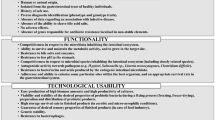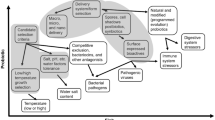Abstract
In-feed antibiotics are administered to piglets to improve performance and production efficiency. However, the use of growth promoters in the swine industry can select for multidrug-resistant (MDR) bacteria. Here, we evaluate the resistance profile of enterobacteria isolated from fecal samples of weaned pigs (21–35 days) fed or not with antibiotics (colistin and tylosin) and investigated the piglets gut microbiota in both groups. Six hundred and eighteen bacterial cultures were isolated from the control group (CON; n = 384) and antibiotic-fed pigs (ATB; n = 234). All isolates were tested for resistance to 12 antibiotics belonging to six distinct antibiotic classes. Isolates were highly resistant to ampicillin (90%; n = 553), amoxicillin (85%; n = 525), and tetracycline (81%; n = 498). A significant increase (P < 0.05) in resistance to cephalexin, kanamycin, doxycycline, and colistin was observed for bacteria from the ATB group. Piglets allocated in the ATB and CON groups shared similar intestinal microbiota, as revealed by alpha- and beta-diversity analyses. Our findings demonstrate that colistin and tylosin contribute to select MDR enterobacteria in weaned piglets. The high frequency of antibiotic resistance among isolates from the CON group suggests that environmental sources (e.g., fecal contents, aerosols, soil, water, food) also represent a potential reservoir of multidrug-resistant enterobacteria in pig production systems.





Similar content being viewed by others
Data Availability
The datasets generated during and/or analyzed during the current study are available in the European Nucleotide Archive (ENA) repository, (https://www.ebi.ac.uk/ena/browser/view/PRJEB35520) and in the National Center for Biotechnology Information (NCBI) repository (https://www.ncbi.nlm.nih.gov/bioproject/PRJNA601169).
Code Availability
Not applicable.
6. References
Burow E, Rostalski A, Harlizius J, Gangl A, Simoneit C, Grobbel M, Kollas C, Tenhagen B-A, Käsbohrer A (2019) Antibiotic resistance in Escherichia coli from pigs from birth to slaughter and its association with antibiotic treatment. Prev Vet Med 165:52–62. https://doi.org/10.1016/j.prevetmed.2019.02.008
Fang J, Shen Y, Qu D, Han J (2019) Antimicrobial resistance profiles and characteristics of integrons in Escherichia coli strains isolated from a large-scale centralized swine slaughterhouse and its downstream markets in Zhejiang, China. Food Control 95:215–222. https://doi.org/10.1016/j.foodcont.2018.08.003
Forshell LP, Wierup M (2006) Salmonella contamination: a significant challenge to the global marketing of animal food products. Rev Sci Tech 25(2):541–554. https://doi.org/10.20506/rst.25.2.1683
Costa E, Uwiera RRE, Kastelic JP, Selinger LB, Inglis GD (2011) Non-therapeutic administration of a model antimicrobial growth promoter modulates intestinal immune responses. Gut Pathog 3(1):14. https://doi.org/10.1186/1757-4749-3-14
Bergen PJ, Bulman ZP, Landersdorfer CB, Smith N, Lenhard JR, Bulitta JB, Nation RL, Li J, Tsuji BT (2015) Optimizing polymyxin combinations against resistant Gram-negative bacteria. Infect Dis Ther 4(4):391–415. https://doi.org/10.1007/s40121-015-0093-7
Rhouma M, Beaudry F, Thériault W, Letellier A (2016) Colistin in pig production: chemistry, mechanism of antibacterial action, microbial resistance emergence, and one health perspectives. Front Microbiol 7:1789–1789. https://doi.org/10.3389/fmicb.2016.01789
Velkov T, Thompson PE, Nation RL, Li J (2010) Structure−activity relationships of polymyxin antibiotics. J Med Chem 53(5):1898–1916. https://doi.org/10.1021/jm900999h
Olaitan AO, Morand S, Rolain J-M (2016) Emergence of colistin-resistant bacteria in humans without colistin usage: a new worry and cause for vigilance. Int J Antimicrob 47(1):1–3. https://doi.org/10.1016/j.ijantimicag.2015.11.009
Falgenhauer L, Waezsada S-E, Yao Y, Imirzalioglu C, Käsbohrer A, Roesler U, Michael GB, Schwarz S, Werner G, Kreienbrock L, Chakraborty T (2016) Colistin resistance gene mcr-1 in extended-spectrum β-lactamase-producing and carbapenemase-producing Gram-negative bacteria in Germany. Lancet Infect Dis 16(3):282–283. https://doi.org/10.1016/S1473-3099(16)00009-8
Rostagno H, Albino L, Donzele J, Gomes P, Oliveira R, Lopes D, Ferreira A, Barreto ST, Euclides R (2011) Brazilian tables for poultry and swine: composition of feedstuffs and nutritional requirements, 3rd edn. Universidade Federal de Viçosa, Viçosa
Clinical and Laboratory Standards Institute (CLSI) (2016) Performance standards for antimicrobial susceptibility testing, 26th edn. Clinical and Laboratory Standards Institute, Wayne
Turlej-Rogacka A, Xavier BB, Janssens L, Lammens C, Zarkotou O, Pournaras S, Goossens H, Malhotra-Kumar S (2018) Evaluation of colistin stability in agar and comparison of four methods for MIC testing of colistin. Eur J Clin Microbiol Infect Dis 37(2):345–353. https://doi.org/10.1007/s10096-017-3140-3
Clinical and Laboratory Standards Institute (CLSI) (2013) Performance standards for antimicrobial disk and dilution susceptibility tests for bacteria isolated from animals, 2nd edn. Clinical and Laboratory Standards Institute, Wayne
Magiorakos AP, Srinivasan A, Carey RB, Carmeli Y, Falagas ME, Giske CG, Harbarth S, Hindler JF, Kahlmeter G, Olsson-Liljequist B, Paterson DL, Rice LB, Stelling J, Struelens MJ, Vatopoulos A, Weber JT, Monnet DL (2012) Multidrug-resistant, extensively drug-resistant and pandrug-resistant bacteria: an international expert proposal for interim standard definitions for acquired resistance. Clin Microbiol Infect 18(3):268–281. https://doi.org/10.1111/j.1469-0691.2011.03570.x
Versalovic J, Schneider M, De Bruijn F, Lupski JR (1994) Genomic fingerprinting of bacteria using repetitive sequence-based polymerase chain reaction. Methods Mol Cell Biol 5(1):25–40
Sambrook J, Russell DW (2006) Preparation of plasmid DNA by alkaline lysis with sodium dodecyl sulfate: minipreps. CSH Protoc. https://doi.org/10.1101/pdb.prot093344
Stevenson DM, Weimer PJ (2007) Dominance of Prevotella and low abundance of classical ruminal bacterial species in the bovine rumen revealed by relative quantification real-time PCR. Appl Microbiol Biotechnol 75(1):165–174. https://doi.org/10.1007/s00253-006-0802-y
Lopes DRG, La Reau AJ, Duarte MdS, Detmann E, Bento CBP, Mercadante MEZ, Bonilha SFM, Suen G, Mantovani HC (2019) The bacterial and fungal microbiota of nelore steers is dynamic across the gastrointestinal tract and its fecal-associated microbiota is correlated to feed efficiency. Front Microbiol. https://doi.org/10.3389/fmicb.2019.01263
Schloss PD, Westcott SL, Ryabin T, Hall JR, Hartmann M, Hollister EB, Lesniewski RA, Oakley BB, Parks DH, Robinson CJ, Sahl JW, Stres B, Thallinger GG, Van Horn DJ, Weber CF (2009) Introducing mothur: open-source, platform-independent, community-supported software for describing and comparing microbial communities. Appl Environ Microbiol 75(23):7537. https://doi.org/10.1128/AEM.01541-09
Edgar RC, Haas BJ, Clemente JC, Quince C, Knight R (2011) UCHIME improves sensitivity and speed of chimera detection. Bioinformatics 27(16):2194–2200. https://doi.org/10.1093/bioinformatics/btr381
Quast C, Pruesse E, Yilmaz P, Gerken J, Schweer T, Yarza P, Peplies J, Glöckner FO (2013) The SILVA ribosomal RNA gene database project: improved data processing and web-based tools. Nucleic Acids Res 41(D1):D590–D596. https://doi.org/10.1093/nar/gks1219
Hammer Ø, Harper DAT, Ryan PD (2001) PAST: Paleontological statistics software package for education and data analysis. Palaeontol Electron 4:1–9
Parks DH, Tyson GW, Hugenholtz P, Beiko RG (2014) STAMP: statistical analysis of taxonomic and functional profiles. Bioinformatics 30(21):3123–3124. https://doi.org/10.1093/bioinformatics/btu494
Iwu CJ, Iweriebor BC, Obi LC, Basson AK, Okoh AI (2016) Multidrug-resistant Salmonella isolates from swine in the Eastern Cape Province. South Africa J Food Prot 79(7):1234–1239. https://doi.org/10.4315/0362-028X.JFP-15-224
Liu Z, Zhang Z, Yan HE, Li J, Shi LEI (2015) Isolation and molecular characterization of multidrug-resistant Enterobacteriaceae strains from pork and environmental samples in Xiamen China. J Food Prot 78(1):78–88. https://doi.org/10.4315/0362-028X.JFP-14-172
World Health Organization (2017) “Integrated surveillance of antimicrobial resistance in foodborne bacteria: application of a one health approach: guidance from the WHO Advisory Group on Integrated Surveillanec of Antimicrobial Resistance (AGISAR).” World Health Organization, Geneva
Mechesso AF, Park SC (2020) Tylosin exposure reduces the susceptibility of Salmonella typhimurium to florfenicol and tetracycline. BMC Vet Res 16(1):1–8. https://doi.org/10.1186/s12917-020-2246-5
Ramirez MS, Tolmasky ME (2010) Aminoglycoside modifying enzymes. Drug Resist Updat 13(6):151–171. https://doi.org/10.1016/j.drup.2010.08.003
MAPA (2009) Ministério da Agricultura, Pecuária e Abastecimento. In: Secretaria de Defesa Agropecuária.
Scientific Advisory Group on Antimicrobials of the Committee for Medicinal Products for Veterinary Use (2009) Reflection paper on the use of third and fourth generation cephalosporins in food producing animals in the European Union: development of resistance and impact on human and animal health. J Vet Pharmacol Ther 32(6):515–533. https://doi.org/10.1111/j.1365-2885.2009.01075.x
Muirhead MR, Alexander TJ (1997) Managing pig health and the treatment of disease: a reference for the farm. 5M Enterprises Ltd, Sheffield
Kengne M, Fotsing O, Ndomgue T, Nwobegahay JM (2019) Antibiotic susceptibility patterns of Staphylococcus aureus strains isolated at the Yaounde Central Hospital, Cameroon: a retro prospective study. Pan Afr Med J 32(32):103. https://doi.org/10.11604/pamj.2019.32.103.15743
Zhang H, Wang P-L, Yang Q-X, Yu N (2018) Distribution of multidrug-resistant bacteria and antibiotic-resistant genes in livestock manures. J Environ Sci (China) 39(1):460–466. https://doi.org/10.13227/j.hjkx.201705169
Sun J, Yang R-S, Zhang Q, Feng Y, Fang L-X, Xia J, Li L, Lv X-Y, Duan J-H, Liao X-P, Liu Y-H (2016) Co-transfer of blaNDM-5 and mcr-1 by an IncX3–X4 hybrid plasmid in Escherichia coli. Nat Microbiol 1(12):16176. https://doi.org/10.1038/nmicrobiol.2016.176
Campos MA, Vargas MA, Regueiro V, Llompart CM, Albertí S, Bengoechea JA (2004) Capsule polysaccharide mediates bacterial resistance to antimicrobial peptides. Infect Immun 72(12):7107. https://doi.org/10.1128/IAI.72.12.7107-7114.2004
Wen Z, Zhang J-R (2015) Chapter 3—bacterial capsules. In: Tang Y-W, Sussman M, Liu D, Poxton I, Schwartzman J (eds) Molecular medical microbiology, 2nd edn. Academic Press, Boston, pp 33–53
Glock XTP, Bilkei G (2005) The effect of postparturient urogenital diseases on the lifetime reproductive performance of sows. Can Vet J 46(12):1103–1107
Menin Á, Reck C, Capelli JC, Ferraz SM, Vaz EK (2008) Diagnóstico de infecção urinária em fêmeas suínas produtivas em granjas comerciais no sul do Brasil. Ciênc Anim Bras 9(1):197–206
Gaastra W, Kusters JG, van Duijkeren E, Lipman LJA (2014) Escherichia fergusonii. Vet Microbiol 172(1–2):7–12. https://doi.org/10.1016/j.vetmic.2014.04.016
Rayamajhi N, Cha SB, Shin SW, Jung BY, Lim S-K, Yoo HS (2011) Plasmid typing and resistance profiling of Escherichia fergusonii and other Enterobacteriaceae isolates from South Korean farm animals. Appl Environ Microbiol 77(9):3163. https://doi.org/10.1128/AEM.02188-10
Bolotin E, Hershberg R (2017) Horizontally acquired genes are often shared between closely related bacterial species. Front Microbiol. https://doi.org/10.3389/fmicb.2017.01536
Funding
This research was funded by the Coordenação de Aperfeiçoamento de Pessoal de Nível Superior (CAPES; Brasília, Brazil), Conselho Nacional de Desenvolvimento Científico e Tecnológico (CNPq; Brasília, Brazil) (Grant 156297/2018–3), Fundação de Amparo à Pesquisa do Estado de Minas Gerais (FAPEMIG; Belo Horizonte, Brazil), and INCT Ciência Animal.
Author information
Authors and Affiliations
Contributions
All authors contributed to the study conception and design. Material preparation, data collection, and analysis were performed by Marlon do Valle Barroso, Juliana Soares da Silva, Sofia Magalhães Moreira, Yasmin Neves Vieira Sabino, and Hilário C. Mantovani. The first draft of the manuscript was written by Marlon do Valle Barroso and Juliana Soares da Silva and all authors commented on previous versions of the manuscript. All authors read and approved the final manuscript. All authors agree to be accountable for all aspects of the work in ensuring that questions related to the accuracy or integrity of any part of the work are appropriately investigated and resolved.
Corresponding author
Ethics declarations
Conflict of interest
On behalf of all authors, the corresponding author states that there is no conflict of interest.
Ethical Approval
All experimental procedures involving animal manipulation were performed following guidelines approved by the Ethics Committee on the Use of Production Animals of Universidade Federal de Viçosa (CEUAP/UFV, Protocol nº053/2017). The experiment was carried out in the nursery rooms of the swine sector of the Animal Science Department at the Universidade Federal de Viçosa, Brazil.
Additional information
Publisher's Note
Springer Nature remains neutral with regard to jurisdictional claims in published maps and institutional affiliations.
Supplementary Information
Below is the link to the electronic supplementary material.
Rights and permissions
Springer Nature or its licensor holds exclusive rights to this article under a publishing agreement with the author(s) or other rightsholder(s); author self-archiving of the accepted manuscript version of this article is solely governed by the terms of such publishing agreement and applicable law.
About this article
Cite this article
do V. Barroso, M., da Silva, J.S., Moreira, S.M. et al. Selection of Multidrug-Resistant Enterobacteria in Weaned Pigs and Its Association With In-feed Subtherapeutic Combination of Colistin and Tylosin. Curr Microbiol 79, 349 (2022). https://doi.org/10.1007/s00284-022-03053-7
Received:
Accepted:
Published:
DOI: https://doi.org/10.1007/s00284-022-03053-7




